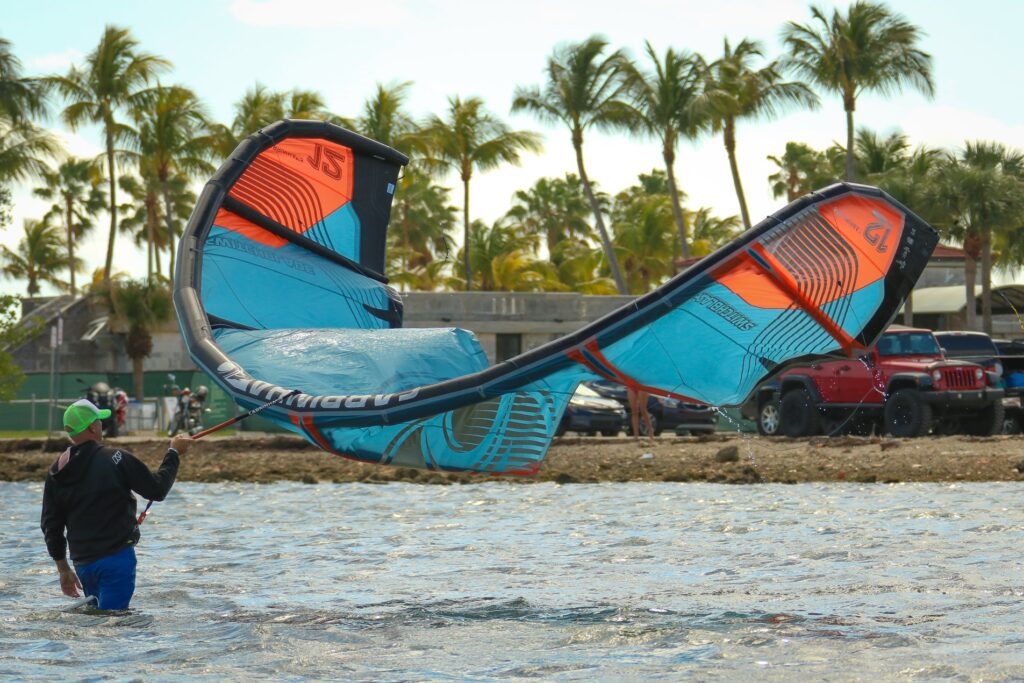
I. Introduction:
- Briefly introduce the topic of kiteboarding and the importance of knowing how to self-launch a kite.
II. Preparing for Self-Launch
- Ensure no interference from other kiters.
- Check the condition of the lines and ensure they are not crossed.
- Verify that the lines are properly wrapped or embedded in the bar.
- Connect the kite to the harness.
III. Executing the Self-Launch
- Walk at an angle of about 32 degrees from the current.
- Release the leash only after untying the bar lines and ensuring the bar is clear.
- Walk backward to tighten the lines and position the kite for a safe and quick launch.
- Choose the appropriate line to lift the kite.
IV. Safety Tips and Considerations
- Be aware of other kiters in the vicinity.
- Keep the lines untangled and clear of obstacles.
- Pay attention to the wind and current conditions.
- Practice self-launching in controlled environments before attempting it in more challenging conditions.
V. Conclusion
- Recap the importance of self-launching safely and confidently.
- Encourage practice and continuous improvement in kiteboarding skills.
VI. FAQs
- Is self-launching suitable for beginners?
- What should I do if I encounter difficulties during the self-launch?
- Can I self-launch in strong winds?
- Should I wear any specific safety gear during self-launch?
- Are there any alternatives to self-launching a kite?
How to Make a Self-Launch in the Water: Step-by-Step Guide
Kiteboarding, a thrilling water sport that combines elements of surfing and wakeboarding, requires expertise and knowledge to ensure a safe and enjoyable experience. One essential skill for kiteboarders is the ability to self-launch their kite, particularly when there are no available assistants or launch spots. This article will guide you through making a self-launch in the water, providing step-by-step instructions to help you lift your kite smoothly and confidently.
Introduction
Before we dive into the details, let’s emphasize the importance of understanding how to self-launch a kite. As a kiteboarder, getting your kite up in the air independently is convenient and crucial for ensuring your safety and the safety of others. Mastering this skill allows you to enjoy kiteboarding sessions even when no fellow kiters or designated launch areas are nearby. Now, let’s get started with the step-by-step instructions for a successful self-launch.
Preparing for Self-Launch
- Ensure no interference from other kiters: Before attempting a self-launch, it’s vital to choose a location where no other kiters nearby could potentially interfere with your maneuver. This will help prevent accidents and ensure a smooth launch.
- Check the condition of the lines: Before launching, inspect your kite lines to ensure they are properly run and not crossed. It’s essential to have all lines untangled and free from any knots or twists. Crossed lines can lead to loss of control and potentially dangerous situations.
- Verify proper line wrapping or embedding: Ensure your lines are well wrapped or embedded in your bar. This will prevent them from tangling during the launch and give you better control over the kite.
- Connect the kite to the harness: Ensure your kite is securely hooked as you enter the water. This connection is essential for maintaining control over the kite during the launch.

Executing the Self-Launch
- Walk at about 32 degrees: To initiate the self-launch, start walking at an angle of approximately 32 degrees from the current. Walking in this direction will help prevent your lines from getting tangled under the kite when the wind and current come into play.
- Release the leash after untying bar lines: As you position yourself for the launch, it’s crucial to release the leash only after untying the bar lines and ensure no lines above or below the bar. This step ensures a clear path for the kite to take off smoothly.
- Walk backward to tighten the lines: After releasing the leash, take a few steps back while keeping tension on the lines. This backward movement will help the lines tighten and position the kite optimally for a faster and safer launch.
- Choose the appropriate line to lift the kite: Depending on your preferred side for lifting the kite, always take the line above, never the line below. Choosing the correct line will determine the take-off direction and prevent sudden changes in the kite’s trajectory.
Safety Tips and Considerations
While self-launching your kite, it’s essential to prioritize safety and consider the following tips:
- Be aware of other nearby kiters: Even though you’re performing a self-launch, it’s crucial to be mindful of others in the area. Maintain a safe distance and avoid launching near others to prevent accidents and potential collisions.
- Keep the lines untangled and clear of obstacles: Throughout the self-launch process, ensure the lines remain untangled and free from obstructions. This will prevent snags and entanglements that could lead to accidents or loss of control.
- Pay attention to the wind and current conditions: Before attempting a self-launch, carefully assess the wind and current conditions. Strong winds or unfavorable currents can make self-launching challenging and potentially dangerous. Practice self-launching in controlled environments before attempting it in more demanding conditions.
- Practice, practice, practice: Self-launching is a skill that requires practice to master. Start in calm conditions, gradually increasing the difficulty as you gain confidence and experience. Regular practice will enhance your ability to execute smooth and controlled self-launches.
Conclusion
Mastering the art of self-launching your kite is an important skill for any kiteboarder. Following the step-by-step instructions outlined in this article, you can confidently and safely lift your kite in the water, even when assistance is unavailable. Remember to prioritize safety, be aware of your surroundings, and practice regularly to improve your self-launching technique.
FAQs
- Is self-launching suitable for beginners? Yes, self-launching is a skill that beginners can learn. However, it’s essential to have a solid understanding of kite control and safety procedures before attempting self-launches.
- What should I do if I encounter difficulties during the self-launch? If you experience difficulties during a self-launch, remaining calm and assessing the situation is crucial. If necessary, seek assistance from other experienced kiters or abort the launch if safety is compromised.
- Can I self-launch in strong winds? Self-launching in strong winds can be challenging and should only be attempted by experienced kiteboarders. Assessing the wind conditions and your skill level is crucial before deciding to self-launch in strong winds.
- Should I wear any specific safety gear during self-launch? During self-launches, wearing appropriate safety gear, such as a helmet and a personal flotation device (PFD) is essential. Additionally, wearing protective clothing and impact vests can provide extra protection.
- Are there any alternatives to self-launching a kite? If self-launching is not possible or if you
Author
Latest entries
 WatersportsSeptember 16, 2024Cabrinha Moto X: Enjoy the Ride
WatersportsSeptember 16, 2024Cabrinha Moto X: Enjoy the Ride WatersportsMay 19, 2024Cabrinha 2024 Moto XL Review: The Ultimate Lightwind Kite
WatersportsMay 19, 2024Cabrinha 2024 Moto XL Review: The Ultimate Lightwind Kite WatersportsDecember 16, 2023Kiteboarding Travel
WatersportsDecember 16, 2023Kiteboarding Travel WatersportsDecember 14, 2023RED BULL KING OF THE AIR 2023
WatersportsDecember 14, 2023RED BULL KING OF THE AIR 2023




